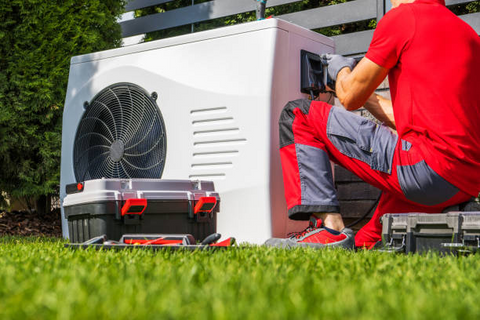Air to water heat pumps have emerged as eco-friendly alternatives for heating and cooling homes. These systems efficiently extract heat from the outside air and transfer it to your home's heating system or hot water tank. If you're considering installing an air to water heat pump to make your home more energy-efficient, this guide will walk you through the essential steps.

- Assessment and Planning:
Before diving into the installation process, conduct a thorough assessment of your home's heating and hot water needs. Consider factors like insulation, the size of your property, and local climate conditions. This assessment will guide you in choosing the right-sized heat pump for optimal efficiency.
- Choose the Right Location:
Selecting the right location for your heat pump is crucial for its efficiency. The outdoor unit, which extracts heat from the air, should be placed in a well-ventilated area with sufficient airflow. Ensure that the unit is placed away from obstructions like tall vegetation or structures that might impede airflow.
- Indoor Unit Placement:
The indoor unit, responsible for transferring heat to your heating system or hot water tank, is typically installed in a utility room or a space with good air circulation. The location should allow for easy access for maintenance and repairs.
- Installation of Outdoor Unit:
Install the outdoor unit on a stable surface, preferably on a concrete pad. This ensures stability and minimizes vibrations. Follow the manufacturer's guidelines for securing the unit and maintaining proper clearances around it.
- Refrigerant Lines and Connections:
Connect the refrigerant lines between the outdoor and indoor units. This is a critical step that requires precision. Make sure the lines are adequately insulated to prevent heat loss during the transfer process. Double-check all connections for leaks.
- Electrical Connections:
Air to water heat pumps require electrical connections to power the system. Ensure that the electrical work is done by a qualified electrician. The installation should comply with local building codes and safety standards.
- Integration with Existing Heating System:
If you're retrofitting an air to water heat pump into an existing heating system, ensure proper integration. This may involve modifications to your existing system or the addition of a buffer tank to optimize the heat pump's performance.
- Commissioning and Testing:
Once all the components are in place, commission the heat pump. This involves running tests to ensure that the system is operating correctly and efficiently. Check the system's performance under various conditions to identify and address any issues.
- User Training:
Provide training to the end-user (typically the homeowner) on how to operate and maintain the air to water heat pump. This includes understanding the control interface, setting temperatures, and recognizing when maintenance or professional service is required.
- Regular Maintenance:
To ensure optimal performance and longevity, perform regular maintenance on your air to water heat pump. This includes cleaning filters, inspecting refrigerant levels, and scheduling professional servicing as recommended by the manufacturer.
- Monitor Energy Consumption:
Keep track of your energy consumption to assess the efficiency of the system. Many modern heat pumps come with monitoring features that allow you to evaluate performance and identify opportunities for improvement.
- Explore Renewable Energy Incentives:
Check with local authorities for available incentives or rebates for installing renewable energy systems like air to water heat pumps. Many regions offer financial incentives to encourage the adoption of sustainable technologies.
Conclusion:
Installing an air to water heat pump can significantly reduce your home's carbon footprint and energy bills. While the installation process involves multiple steps, meticulous planning and adherence to manufacturer guidelines and local regulations will ensure a smooth and efficient installation. By harnessing the power of the outdoor air, air to water heat pumps contribute to a more sustainable and comfortable living environment.

